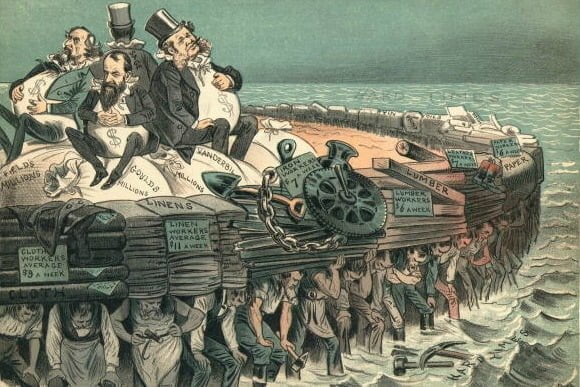When we think of slavery we immediately cast our minds back to the horrors of the transatlantic slave trade. But while chattel slavery of such scale and savagery has been consigned to the history books, there are in fact more slaves in the world today than at the height of the colonial slave trade.
When we think of slavery we immediately cast our minds back to the horrors of the transatlantic slave trade, which reached its peak in the 18th and 19th centuries. But while chattel slavery of such scale and savagery has been consigned to the history books, slavery in all its forms has never truly been abolished. In fact, there are more slaves in the world today than at the height of the colonial slave trade.
Widespread
Modern slavery arises in many forms across the world and blights the lives of millions of suffering people. It is estimated by the International Labour Organisation that 21 million people are currently trapped in slavery, and the so-called “advanced” capitalist countries, like Britain, are by no means immune.
The UK’s National Crime Agency (NCA) has had to recently revise its figures for the estimation of slaves in Britain, as previous estimates of 10,000-13,000 were seen as just the ‘tip of the iceberg’. The real figure is unknown but assumed to be far higher. Will Kerr, an NCA spokesperson, stated: “As you go about your normal daily life there is a growing and a good chance that you will come across a victim who has been exploited and that’s why we are asking the public to recognise their concerns and report them.”
Trafficked victims into the UK are forced into labour-intensive industries such as agriculture and construction, but along with this are the people who are trafficked purely for sexual exploitation, 98% of whom are women and girls. Young girls are often deliberately targeted for their vulnerability, and it’s estimated that one in four victims of slavery in the UK are children.
In order to counter the growing problem of slavery within the UK, Theresa May signed into law the “Modern Slavery Act” in 2015, when she was acting Home Secretary. It was intended to increase conviction rates and give police more powers of prosecution, as well as establishing an independent Anti-Slavery Commissioner to overlook the UK’s anti-slavery policies and make UK businesses publically report on how they tackle slavery in their global supply chains.
However, the UK government’s legislative efforts have largely been in vain as the number of slaves in the UK has continued to rise. ‘Anti-Slavery’s Europe Programme and Advocacy Coordinator, Klara Skrivankova, said her organisation had “mixed feelings” about the Act and explained, “On one hand it is a big step in the right direction with many good clauses but on the other there are still deficiencies that leave us – and victims of modern slavery – wholly unsatisfied”.
A major problem with national anti-slavery legislation is the necessarily international nature of human trafficking, often linked with poverty and exploitation abroad as well as at home. A majority of victims of slavery in the U.K were originally trafficked from overseas, with the most commons countries of origin being Albania, Vietnam, Nigeria, Romania and Poland.
It is worth noting that 4 out of 5 of these states are former Communist states which have been reintroduced to the global capitalist system within the last 30 years. After the dissolution of the USSR and the liberalisation of the markets in Asia, we’ve seen drastic falls in living standards and working conditions in these places. It is no wonder that these countries, as well as the European colonies, are among the main sources of modern slavery.
Lucrative
 Another reason why capitalist governments have not been able to abolish slavery for good is that it is shockingly lucrative. Modern slavery generates over £115 billion per year, making it the third largest criminal industry behind gun smuggling and drug trafficking, all three of which act as a damning indictment of capitalism and its failures. Further, the profits accumulated from slavery have a positive knock-on effect for the bourgeoisie whether they care to admit it or not.
Another reason why capitalist governments have not been able to abolish slavery for good is that it is shockingly lucrative. Modern slavery generates over £115 billion per year, making it the third largest criminal industry behind gun smuggling and drug trafficking, all three of which act as a damning indictment of capitalism and its failures. Further, the profits accumulated from slavery have a positive knock-on effect for the bourgeoisie whether they care to admit it or not.
For capitalists, slaves can be a very attractive investment as the slave-owner need only pay for basic sustenance and the cost of enforcement, which can sometimes be much lower than wages.
The use of slave labour on Qatari construction sites is just one high-profile example of this fact. Slaves can also be forced to do particularly gruelling work or illegal work like smuggling or drug manufacturing. An estimated 2.2 million people in slavery are actually exploited directly by their governments through prison labour or forced debt repayment.
This limits the ability of international authorities to clamp down upon the practice, because behind the scenes many capitalists and states are unwilling to forgo these benefits. This is most clearly seen in the third world, where the interests of the ruling classes are less hidden behind the veneer of ‘democracy’ and ‘rule of law’. States will often tacitly allow various forms of slavery, despite it being outlawed by international treaties. The conscription of child soldiers by some governments is also often viewed as a form of government-endorsed slavery.
Another shocking example is that of the Moroccan government which, according to a 2014 report commissioned by the US State Department, has turned a blind eye to the booming trade forced labour and sex trafficking that operates within its borders. Girls as young as six are recruited from rural areas into the cities and forced into domestic work and prostitution; young boys are more commonly forced into construction or mechanical work. Migrant workers from Sub-Saharan Africa, primarily from the Ivory Coast and the Congo regularly fall victim to traffickers and criminal gangs who subject them to brutal working conditions and force them into slavery using violence, threats, extortion and the withholding of passports. Many will them be smuggled into Europe.
But this problem is certainly not confined to Morocco. Globally only 9,000 anti-slavery convictions were made in 2016. Combine this with the fact that the total number of people in slavery is rising year on year and you can see that as capitalism slides further into decay the super-exploited layers of the masses are being increasingly pushed into slavery.
Wage slavery
 The history of capitalism is inherently bound and tied up with slavery; as capitalism relentlessly and unceasingly aims to commodify and turn a profit on everything, nothing can be sacred or off limits. Therefore people’s bodies, lives and sex are all commodified in the most dehumanising and abusive ways. When nation states and global lawmakers try to criminalize and prosecute slavery, they are merely trying to cut away and cover up the lowest and most inhumane rungs of the capitalist ladder. We must ask ourselves: ‘If slavery is illegal in every country, then why are there more slaves in bondage now than there ever have been throughout humanity’s history?’
The history of capitalism is inherently bound and tied up with slavery; as capitalism relentlessly and unceasingly aims to commodify and turn a profit on everything, nothing can be sacred or off limits. Therefore people’s bodies, lives and sex are all commodified in the most dehumanising and abusive ways. When nation states and global lawmakers try to criminalize and prosecute slavery, they are merely trying to cut away and cover up the lowest and most inhumane rungs of the capitalist ladder. We must ask ourselves: ‘If slavery is illegal in every country, then why are there more slaves in bondage now than there ever have been throughout humanity’s history?’
The blame must be aimed squarely at the capitalist system, within which the class basis, material conditions, and economic impetus are always present for exploitation. This means that slavery will continue, it will just operate outside the jurisdiction of bourgeois law. Slavery itself can be viewed as just the most brutal and decrepit form of capitalist exploitation.
Indeed, the similarities between “normal”, acceptable exploitation (under capitalism) and slavery are uncomfortably close. A striking example of this is seen in the definition of slavery that is presented by ‘Anti-Slavery International’, which states that someone is a slave if they are:
- Forced to work – through coercion, or mental or physical threat
- Owned or controlled by an ’employer’, through mental or physical abuse or the threat of abuse
- Dehumanised, treated as a commodity or bought and sold as ‘property’
- Physically constrained or have restrictions placed on their freedom of movement
From the inescapable coercion of wage labour, the mental and physical threats of debt, poverty and starvation, the disgusting treatment of employees by the capitalists – well documented in every country – we see a distressing image appear. Only a thin-line of legality exists between the most exploited and brutalized layers of the working class, and slaves.
According to American professor Kevin Bales, co-founder of ‘Free the Slaves’, modern slavery occurs “when a person is under control of another person, who applies violence and force to maintain that control, and the goal of that control is exploitation”. Is it too much of a stretch to point out that the monopoly of violence utilized by the ruling class upon the workers of the world, comes painfully close to this definition?
Slavery will continue as long as the economic system which breeds it can survive. As long as commodification for profit-making and private property form the bedrock of our society then there will be fertile ground for slavery. Only by the working class taking control of the economy can we remove the basis of exploitation and uncover these secret abuses that are allowed to fester behind closed doors. Armed with a revolutionary programme, workers from all over the globe could break the chains of complicit governments, criminal businesses and trafficking circles, and finally free themselves from exploitation.





